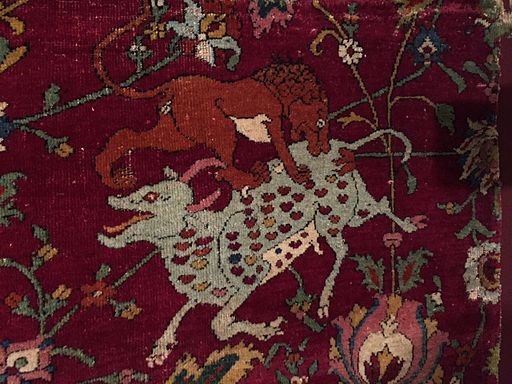There are many different labels throughout the world, ranging from Indian rugs to Tibetan rugs.
In this case, we'll be focusing on an excellent title of rugs that fall under these label categories: Tribal rugs for sale.

For those looking to decorate their home with Tribal rugs for sale, read on for more information. These eye-catching pieces are a great investment.
What is the History of Tribal rugs?
In the Caucasus Mountains, the tradition of tribal rug weaving began.
Most of these tribes had their weaving traditions and produced 85 different styles of rugs using natural dyes throughout the region.
While visiting the Bakhtiari governor of Persia on an expedition, Moroccan traveler Ibn Battuta saw the blue Persian tribal rug that was laid out for him.
He even noted how he had never seen a finer rug before.
A significant variety of Persian rugs came through these groups:
- Qashqai
- Lurs
- Afshar
- Bakhtiari
- Kurdish
- Shahsavan
- Khamseh
Many ancient cultures throughout history have been known to create unique and vibrant rugs.
The historian Herodotus even complimented Armenian rugs for their vivid, timeless hues when they were first introduced in the 5th century.
At first, vintage tribal rugs may not have been well-known outside of North America, but once the 1960s and 1970s came around, they were in high demand among collectors.
In the 1950s and 60s, major auction houses started to sell them to the highest bidders.
Today, it is still possible to find a lot of tribal rugs through online retailers and auctions.
The number of tribal-style pieces that were created in the past as compared to now is an eye-opening contrast.
These antique rugs, which museums have put on display beds, come from different tribes around the world.
How Tribal Rugs Are Made?
Some weavers use camel or goat's wool. They produce tribal-style rugs with the knotting technique in the same way that people used to while others have found no evidence of these knotted horse-hair rugs ever existed in the archaeological record.
It is very difficult to determine when the tribal rug was first created. It could have been during the nomadic period or before that. There is a historical argument that proves it was made back in the 'knotted pile' method that prevailed as tribes were migrating between cities and countries.
Tribal-style rugs have a variety of designs and you can find Tribal rugs online easily nowadays.
Many rugs are typically made using repeated patterns in one field and various colors and designs.
People may see some familiar patterns on Iranian or Persian Tribal rugs including a traditional shape called "boteh" and an eight-pointed star.
You might also find the symbol for life, crosses, and emblems of spiritual meaning like camels and fish.
Unique to Iran are scorpions, spiders, and snakes that surround a mosque as protection and monsters like elibellinde.
Types of Tribal Rugs
1. Afshar Rugs
Afshar is known for its tribal rugs.
These rugs are designed and woven by the Kerman people, who were the most dominant group in the city.
However, these geometric motifs often contrast with other stylized floral designs.
Afshar rugs come in a variety of blue shades and rust shades. Additionally, there are turquoise, dark green, mustard yellow, navy blue, and gold shades.
2. Qashqai Rugs
Weavers from the Qashqai confederacy in Southern Persia’s Zagros mountains created Qashqai rugs.
These rugs have rich and saturated natural dyes.
Qashqai weavers often use vivid indigo, ivory, and red hues then add in other complementary colors to complete the look.
These rugs usually include plant, bird, and animal motifs.
3. Khamseh Rugs
The Khamseh rugs are designed by a confederation of weavers from southern Persia who produce various designs with Turkic, Turkoman, and native Persian-influenced patterns.
Incredibly unique and beautiful Khamseh rugs are one of a kind.
They're made with different ornaments and natural colors to provide an artistic style.
4. Kuba Rugs
The town of Kuba produces products that have a distinctive design iris from East Caucasian motifs like designs with the stripes typical of Daghestan and Shirvan.
The products are still unique such as their feathered crown, fitting for the Karabagh region.
The Kuba is known for the fine knots and closely sheared piles that these rugs showcase.
The colors were made by using natural dyes and they have vibrant colors, which makes them stand out.
5. Northwest Rugs
Northwest rugs offer the same qualities as regions in the south such as Heriz, Caucasus Mountains, and Azerbaijani Tribes.
They have geometric patterns of simplicity and elemental design.
In addition, their weavers use a basic G pattern to weave.
Northwesters are standard runners and area pieces. They're thick and great for your floors.
The most frequent appeal of tribal carpets is their tribal style patterns and designs, which showcase the complicated nature of design themes.
A typical tribal rug, on the other hand, is made up of multiple repeated motifs in a given area, each with a different color palette.
As a result of this, the Tribal weavers were able to recall the designs and produce the carpets without the assistance of specialists or samplers.
The whimsical touches that a weaver improvised in a creative form to show their sense of originality may be seen in a typical Tribal rug.
Handmade Tribal rugs have a lot going for them.
They may bring a distinctive and unique flair to your home décor while also adding an artistic, vibrant touch to any area.
To locate the ideal tribal area rug for your environment, browse our online collection.













